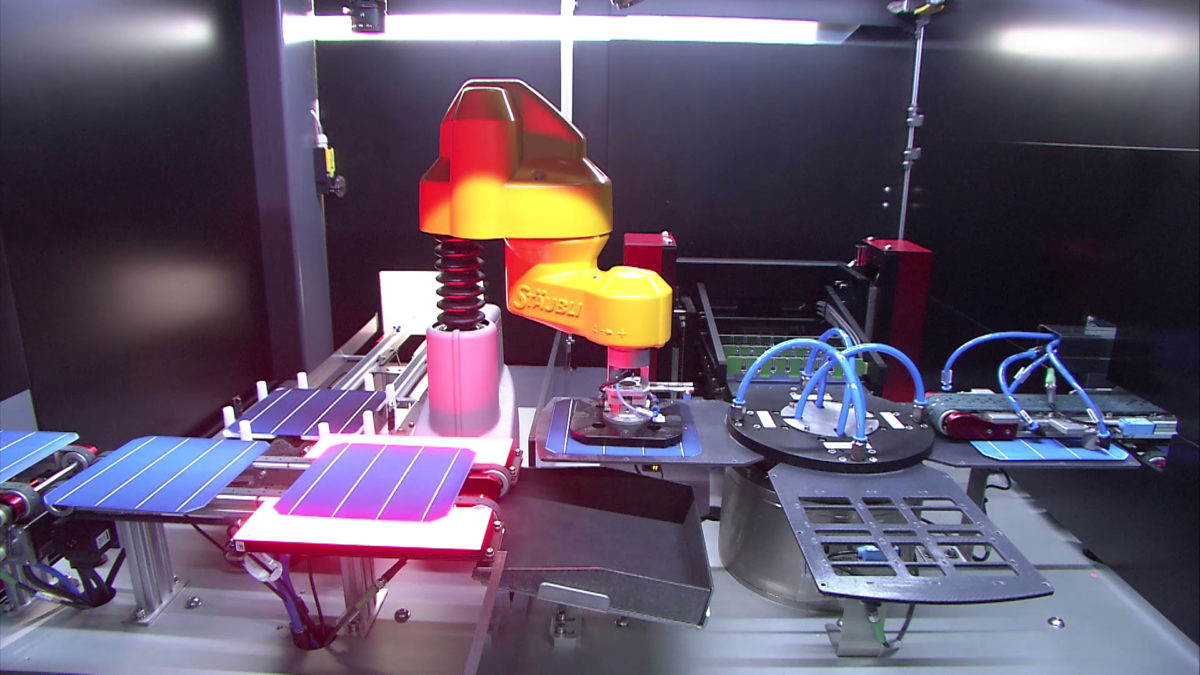After announcing plans for a new module manufacturing facility in the Netherlands in August 2017, Energyra revealed it was preparing the first line at its facility in Zaanstad, near Amsterdam, in early April. The project could move forward, the company said at the time, as it had secured financial backing from the regional government of North Holland, which, alongside contributions from other investors, amounted to a €15 million aggregate initial investment.
The factory
Big empty spaces at the facility give the impression that there is still a long way to go. “the first 100 MW line will be set up soon and it will be operational in September,” responds Energyra CTO John Van Laarhoven, promptly. Van Laarhoven is a pioneer of the Dutch solar industry, having built the country’s first panel factory, that of oil group Shell in the 1980s, and two more small factories in the past decade.
When he shows us the schematics of the line, he points out that the strength of the future production line is to be found in the first two of its three sections: the high throughput mass production lay-up equipment provided by Italy’s Formula E, a unit of Vismunda Group, and the laminator of Germany’s SM Innotech. It is in these two sections that the Metal Wrap Through (MWT) process developed by Energy research Centre of the Netherlands (ECN) will be applied to assemble back contact mono-cSi modules, with cells provided by an unspecified European manufacturer, as well as with conductive backsheets provided by EB Foil, another subsidiary of Italy’s Vismunda.
“The configuration of the line from cell to lamination is very flexible and adaptable to different sizes and architectures of module, including conductive backsheet-glass or glass-glass panels, an option that Energyra is also considering in the future,” managing director of Vismunda Group, Davide Spotti told pv magazine. Avoiding soldering, according to him, is key to reducing breakage rate, cell-to-module loss and power mismatch. “In the manufacturing of traditional solar modules, when you have to solder four or five ribbons on the front and back side of a cell, it is done at between 230 and 250 degrees. When everything goes back to room temperature, this causes a lot of stress inside the cell. This also means that sooner or later microcracks will pop up,” Spotti further explained.
Automation all the way
The equipment provided by Formula E has fully automated control and traceability of all operations, a decisive factor to reduce production costs, the company claims. The entire line is planned to operate relying on only five persons per shift. “This automated flow makes a big difference, we use a fully automated controlled process and our own algorithm to create an architecture that is flexible and variable for number of cells and module configuration”, Spotti also stressed.
The Dutch cell
The Metal Wrap Through (MWT) technology provided by ECN is based on getting the negative front side of the cell to its positive backside by creating a hole, and then transferring the contacts to the backside. “By patterning this, we create a large metal surface that can firstly have the benefit of heat-sinking the solar cell. By distributing the heat, it is easier to get that heat out of the module,” explained Van Laarhoven.
He also added that, through this process, modules with efficiency between 20% and 21% will be produced at the facility, and will provide higher yields compared to similar modules, as cell-to-module losses are expected to be close to zero.
Just another small module maker?
When asked if Energyra is set to become one of these small European panel manufacturers that strive to survive just by not scaling up capacities over a few hundred MW, creating a solid base of regional clients, and taking advantage of minimum import prices for Asian modules, Kuijk said: “the production line will start manufacturing activities in September, when the minimum import price will expire. Furthermore, we are planning to increase capacity to 300 MW by adding a second line at a later stage.” The company’s main plan, on the other hand, envisages the possibility of raising capacities not at a single facility, but by creating more factories of the same size and technology of the Zaanstad’s one.
First orders
Although Energyra is planning to sell its modules in all European markets, it is quite likely that its first orders will come from the Dutch market, whose current development is rather strong. “We already have letters of intent for 200 MW, and Dutch developer Powerfield has recently announced its intention to buy our modules for its big projects,” Kuijk also explained. This initial push, if confirmed, will probably help the company get through the difficult phase of its launch. After that, quality and further technology improvement should be key to real success, regardless of whether Chinese and other Asian manufacturers may also care about quality, something that is not always taken for granted.
This content is protected by copyright and may not be reused. If you want to cooperate with us and would like to reuse some of our content, please contact: editors@pv-magazine.com.




By submitting this form you agree to pv magazine using your data for the purposes of publishing your comment.
Your personal data will only be disclosed or otherwise transmitted to third parties for the purposes of spam filtering or if this is necessary for technical maintenance of the website. Any other transfer to third parties will not take place unless this is justified on the basis of applicable data protection regulations or if pv magazine is legally obliged to do so.
You may revoke this consent at any time with effect for the future, in which case your personal data will be deleted immediately. Otherwise, your data will be deleted if pv magazine has processed your request or the purpose of data storage is fulfilled.
Further information on data privacy can be found in our Data Protection Policy.